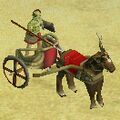Onager
From Warbirth Wiki
- Not to be confused with the Roman siege weapon known as the Catapult.
| Onager — Vital statistics | ||||||||||
|---|---|---|---|---|---|---|---|---|---|---|
|
Stronger and more powerful than Light Chariot, but is costlier. | ||||||||||
| Prereq: | Build time | HP | LOS | Attack | Attack speed | Movement speed |
Upgrades to | |||
| 29.5s (444t) |
122 | 9 | 20 | 1.6s (24t) |
25 | |||||
| Cost | Created from | Armour | Weapon range | Specialty | ||||||
| Base | Ramp | Pop | ||||||||
| 2 | 2 | 1–7 |
| |||||||
Overall strategy[edit | edit source]
An early game ranged cavalry unit shared by Babylon and the Siberians the Onager is a ranged cavalry unit that comes into the game, one age earlier - during the Copper Age. In addition, they enjoy a defence bonus against early-game melee infantry — Peasant Levy, Light Axemen and Spear Levies.
For this reason, the Siberians and Babylon can be a very dangerous foe, early on, since they can train these slow-moving war machines and then use them to "tank" early game armies, driving them headlong into enemy melee infantry and allowing cavalry units - mostly Horsemen - to then exploit the gap and attack missile units which are usually screened by melee infantry. Nevertheless, they are slow and cumbersome, and easily destroyed by units with long range, such as archers - so once you reach the Bronze Age, you should upgrade them to Light Chariots the moment they become available: while these units are weaker, they are cheaper to build, and move faster, thus making them more flexible as offensive units. Additionally, unlike true chariots, Onagers can't attack while moving. So Onagers are best countered using fast-shooting, long range infantry -- that usually means archers, especially Composite Bowmen wherever they can be found.
Unit summary[edit | edit source]
- Medium Chariot — Built by a slew of civs, including the Shang, zhou, Indians and Hittites, this replacement of the Light Chariot is slower but more powerful.
- Maryannu Chariot — The Maryannu Chariot is a unique light chariot unit available to the Mitanni which sacrifices cost advantages in favour of greater speed.
- Werryt — Like the Mitanni, the Egyptians create a unique light chariot unit called the Werryt with faster turn speed as well as faster build time.
- Karbantos — The Celtic Karbantos cannot fire as often nor as far as other Light Chariots, but is highly efficient at destroying infantry units.
See also[edit | edit source]
Notes[edit | edit source]
Khmer light chariot used by Funan must be based off the Celtic Karbantos. A new unit needs to be minted, but it's unknown how this unit would look.
Some ideas:
- Strip the Indian slinger and an Indian longbowman of turbans and heads. Replace the heads with Chinese-style ones.
- Re-rig the Indian longbowman to meet the needs of the new unit.
- Finally, change the colour of the horses from dark brown or red to dirty grey.
- Lightchar cameo 2.jpg
Near Eastern version used for almost all factions in Warbirth: Age of Chariots and Kings & Conquerors: Hammurabi (2nd version).
- Funan lightchar cameo.jpg
Funanese version - used for Asian factions in Warbirth.
- Funan lightchar cameo 2.jpg
Funanese version - used for Asian factions in Warbirth (2nd version).
History[edit | edit source]
A chariot is an ancient horse-drawn two-wheeled vehicle used in primarily for war and transport, then later in races and processions. There is much debate on how the chariot first emerged, with people arguing that chariots first emerged along with the wheel in Mesopotamia. Excavation of graves in the ruins of the old Sumerian city of Ur (near Nasiriyah in present-day Iraq) by Wooley in the 1920s revealed that the Sumerians of the early 3rd millenium BCE used large four-wheeled vehicles possibly drawn by donkeys, but these wagons differed greatly from true chariots, which were built for speed, could at best carry only up to three people, and had two wheels instead of four - possibly for reasons of speed and mobility. In contrast, others postulate an origin with Central Asian horse-breeding cultures. Excavations in Russia during the final years of the Cold War revealed that chariots might have been invented at least 2 millenia earlier by the people of the Eurasian steppes, as represented by the Maykop culture in the Caucasus.
A chariot could either function as a transport for dignitaries (the most common use) or in suitable terrain, be used as a platform for the use of missile weapons in hit-and-run tactics. Regardless of the chariot's origins, what is most certain is that the proliferation of chariotry took place after 2000 BCE in Europe, Asia and the Middle East. One of the culminating battles of chariotry came early in the 13th century BCE when armies of the Hittites and Egyptians clashed on the plains of northern Syria at Qadesh. By the end of that century, as armies learned to blunt the attacks with swarming infantry and later mounted cavalry, the age of the chariot as a weapon drew to a close. The high-speed vehicle was reduced to roles in sport and regal parades.
References[edit | edit source]
- New York Times, 'Remaking the Wheel - Evolution of the Chariot'
